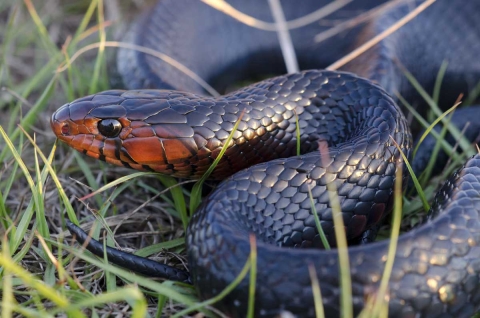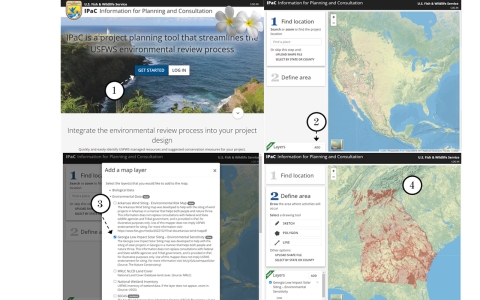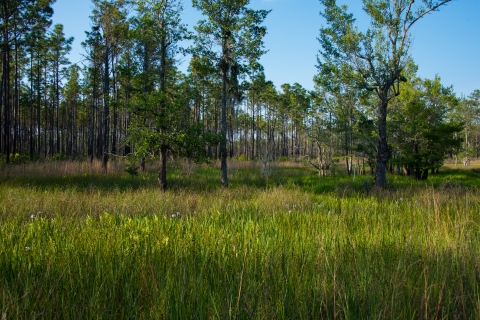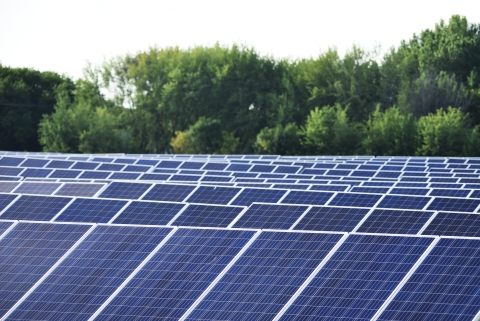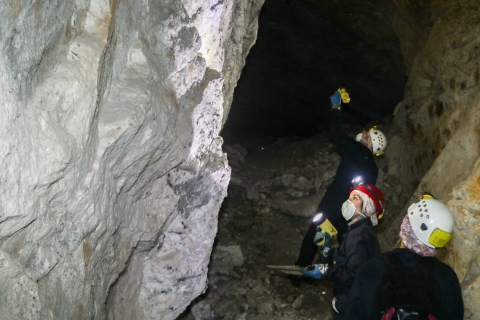Our biologists are here to share effective practices that protect fish, plants, and wildlife and their habitats. This collection of resources can help in planning your future projects or simply learn about imperiled species and best conservation practices.
How can we help?
- Species Info
- Project Review
- Conservation Measures
- Energy Industry Guidance
- Survey Guidance
- Federal Programmatic Agreements
- Emergency Consultation Resources
About Our Species
Georgia is home to more than 600 species of plants and animals of conservation concern. While 76 of these are listed as threatened or endangered under the Endangered Species Act, some species are experiencing population declines and do not have any protection by Federal or state law. Our mission is to educate community members about the incredible biodiversity found in Georgia and to share ways that we can all help to conserve species.
- USFWS Environmental Conservation Online System
- Georgia Department of Natural Resources Biodiversity Portal
Requesting Project Review by Your State and Federal Agencies
The State of Georgia Department of Natural Resources and U.S. Fish and Wildlife Service can provide information about species near a project area and recommend conservation practices that help protect species during development projects.
State Agency Project Review
To request review of your proposed project by our State agency, please visit the Georgia Department of Natural Resources' Environmental Review Page.
Endangered Species Act Project Review
To request review of your proposed project by our agency, please visit the USFWS Information for Planning and Consultation (IPaC). IPaC IPaC
Information for Planning and Consultation (IPaC) is a project planning tool that streamlines the USFWS environmental review process
Learn more about IPaC is a free tool for learning about the federally protected species that may occur in your area or project footprint. There, you can request a Official Species Report and use "determination keys" that help in determining whether a project may impact a species. Currently, the follow determination keys are available for Georgia and more are coming soon: Northern long-eared bat, Multi-state Indiana bat. The USFWS Georgia Ecological Services Project Planning and Review page will help you prepare a report to send to our team for feedback. Please reach out to request assistance in the planning stages.
How to Add Map Layers on IPaC for Project Planning
- From the IPaC Home Page, click "Get Started".
- In the left navigation bar, find the "Layers" menu, and click "Add".
- You will see a series of folders (e.g., Biological Data, Environmental Data). Click the small right-facing arrow to expand these folders and activate different map layers that are available. Then click "OK".
- The data layer you activated should now appear on your map!
Conservation Measures
- USFWS Eastern Indigo Snake Standard Protection Measures
- Final NLEB and TCB Tools and Guidance Frequently Asked Questions
- Northern Long-Eared Bat and Tricolored Bat Zone Map App
- USFWS Migratory Birds Program
- USFWS Avoiding and Minimizing Incidental Take of Migratory Birds Library Collection
- USFWS Bird Collision Reduction Kits
- USFWS Bald and Golden Eagle Management Library Collection
- USFWS Manatee Special Permit Conditions for U.S. Army Corps of Engineers Projects in Georgia
- USFWS Monarch Butterfly Conservation Measures
- USFWS Eastern Black Rail Conservation Recommendations
- U.S. Fish and Wildlife Coordination Act Considerations
- 2022 Stream Crossings in Georgia Handbook
- Best Management Practices for Forestry in Georgia
- Georgia Ecological Services Library
Energy Industry-Specific Considerations
Solar Energy
- USFWS Georgia Ecological Services Field Office's Guidance for Solar Energy
- The Nature Conservancy’s Low-Impact Siting Tool for Solar Facility Development in Georgia
- Recommended Practices for the Responsible Siting and Design of Solar Development in Georgia, Version 2.0 (2024)
Survey Guidelines
- Georgia Department of Natural Resources' Bat Survey Guidelines
- USFWS 2022 Range-wide Indiana Bat and Northern Long-eared Bat Survey Guidelines
- Bats and Transportation Structures Survey Training / Audio-Described Training
- U.S. Army Corps of Engineers Savannah District's Courtesy List of Georgia Environmental Consultants
- USFWS Freshwater Mussel Survey Protocol for the Southeastern Atlantic Slope and Northeastern Gulf Drainages in Florida and Georgia
- Visual Encounter Survey Protocol for the Eastern Indigo Snake (Drymarchon couperi) in Georgia
Federal Programmatic Agreements
- U.S. Army Corps of Engineers Savannah District - Effect Determination Guidance Tools (EDGES)
- Federal Highway Administration - Joint Coordination Procedures for Interagency Consultation among the Federal Highway Administration's Georgia Division and U.S. Fish and Wildlife Service's Georgia Ecological Services, Georgia Department of Natural Resources and Georgia Department of Transportation
- U.S. Department of Housing and Urban Development - Federally Insured Loan and Grant Projects - Region wide clearance letter for projects that meet criteria for "no effect" determinations
- U.S. Department of Agriculture Farm Service Agency - Section 7 Section 7
Section 7 Consultation The Endangered Species Act (ESA) directs all Federal agencies to work to conserve endangered and threatened species and to use their authorities to further the purposes of the Act. Section 7 of the Act, called "Interagency Cooperation," is the mechanism by which Federal agencies ensure the actions they take, including those they fund or authorize, do not jeopardize the existence of any listed species.
Learn more about Section 7 consultation guidance developed by USDA-FSA and Georgia Ecological Services - GAES clearance letter for FSA Emergency Conservation Program, Emergency Forest Restoration Program, Farm Storage Facility Loan, Tree Assistance Program, and FSA Loan Activities - U.S. Federal Communications Commission - Georgia Ecological Services Clearance to Proceed with Construction or Co-location of New Communications Towers less than 200 feet Above Ground Level in accordance with FCC Environmental Review Rules and Guidelines - Document


